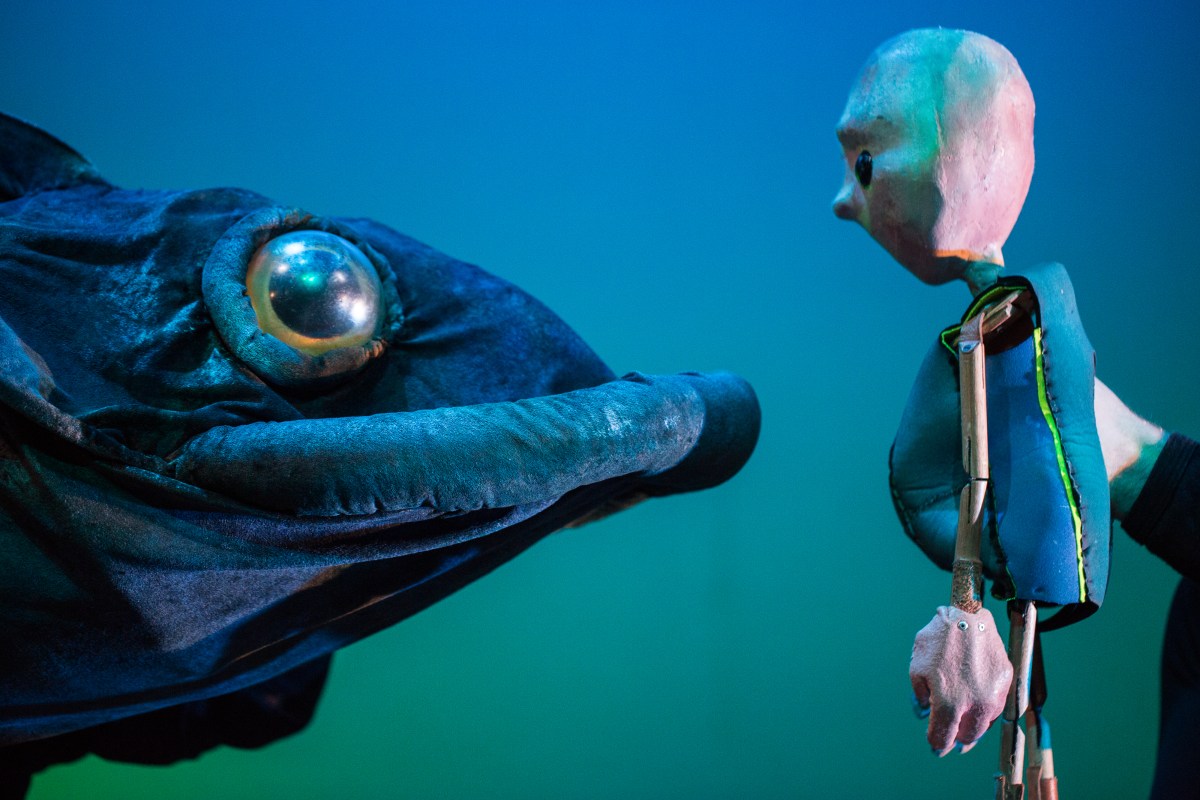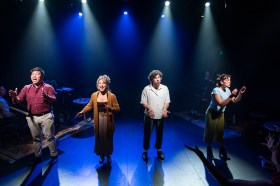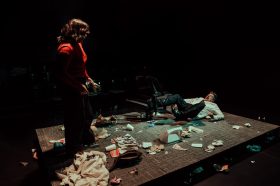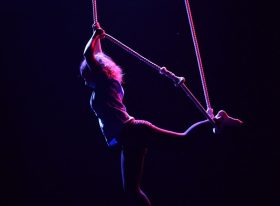Tim Winton’s timeless tale of connection is brought to emotional life under Philip Mitchell’s artistic direction, encouraging audiences to embody aquatic perspectives, perhaps as a remedy to the environmentally damaging impacts of human action. Like the book it is based upon, Blueback tells the story of Abel and his mother Dora, and their overlapping connections with the ocean, and their coastal town.
A blue glow emanates over an imaginative set at the centre of a darkened stage, as oceanic audio guides the audience into the world of Abel and Dora. Abel makes his amniotic emergence as a head on an eel-like body, swimming through a calm red wavescape, cradled within his mother’s steady heartbeat. Gradually, the red glow turns to blue. Flickering lights ripple over the stage to create the impression of submergence, equating prenatal life with ocean living.
Abel reappears as an armed-and-legged puppet boy, but becomes his eel-like-self again during underwater sequences, highlighting how at home he is in the sea. A gulping-mouthed grouper appears as lists of fish species are spoken over the score in an ode to fins and scales. This charismatic grouper is befriended by Abel, who names him Blueback. Together, Abel and Blueback dart playfully through the reef, becoming ever-closer as time passes.
When Abel is a child, he wishes he could know what fish think. When he heads to uni to study fish, Abel’s questions are deepened, rather than answered. Eventually becoming a marine expert, Abel still wishes he knew what fish were thinking. Blueback frames education as an act of activism, but also highlights the importance of concrete experience over abstract detachment.
Clever puppet design and skilful aquatic movements combine to emphasise the similarities between humans and marine life, strengthening empathic connections between the two. Bald-headed human puppets with round black eyes and no mouths are able to embody any emotion projected upon them by the audience. Rather than choosing to anthropomorphise the fish, this production team has ‘aquatified’ the human characters, connecting marine life with humankind, visually and kinetically, to excellent aesthetic effect.
The story is told through impressions, lists, movement and visual poetry rather than the back-and-forth dialogue to which most children are accustomed. The overlapping narratives of Abel and his mother are both complementary and contrasting.
Blueback uses light and sound to create two distinct worlds on either side of the ocean’s surface. Versatile set pieces transform – with the help of evocative lighting and audio cues – from ocean waves and underwater reefs to human homes on land.
Subtle and overt messages of environmentalism abound, appearing in the forms of overfishing, oil spills, broken ecosystems, human greed and the stupidity of fishing as a killing sport.
Capitalism’s frustration with a simple sustainable life results in development encroaching upon traditional lifestyles of coastal fishing towns. Blueback could be interpreted as an analogy of human greed destroying the natural world.
Some of the themes explored within the show are a lot for small children. These include, but are not limited to, the loss of loved ones and the destruction of beloved environments. True to Winton’s style, Blueback deals with death in a sensitive but matter-of-fact way.
For example, in a ghostly dream sequence, fishing nets and silhouetted corpses float through an endless ocean. ‘Where do the dead go after they die?’ is a question posed more than once. When the ghost ship returns for a second time, tears may take hold of some people.
Strobe lighting utilised during a storm scene is dramatically effective, but gentle enough not to scare younger audience members. In another scene, it is implied that thousands of whale bones have washed up on the beach, haunting the present with sun-bleached proof of historical harm. A voiceover lists objects made from whales, emphasising the sadness of taking too much from the sea, and the responsibility we share for human action. The tone is meaningful, rather than scary, but parents of particularly sensitive children should keep these aspects in mind.
Read: Exhibition review: Still Water, Henri van Noordenburg, Logan Art Gallery
Blueback centres on the concept of sanctuary as it applies to protected environments, loved ones and home. It ends at the poignant point of a new cycle beginning, and is as enjoyable for adults as it is for children. Maybe we will never know the secrets of the sea, but, as Spare Parts Puppet Theatre’s stunning show, Blueback, reminds us, the ocean will always be full of wonder.
Blueback
Ellie Eaton Theatre, Claremont Showground, WA
Spare Parts Puppet Theatre
Director: Philip Mitchell
Book Author: Tim Winton
Adapting Writer: Peta Murray
Designer: Hanna Parssinen
Composer: Don Hopkins
Performers: Anna Lindstedt and Shaun Johnston
Production Manager: Megan Fitzgerald
Puppet Construction: Greg Methe
Tickets $23-$25
Blueback will be performed until 15 July 2023.





